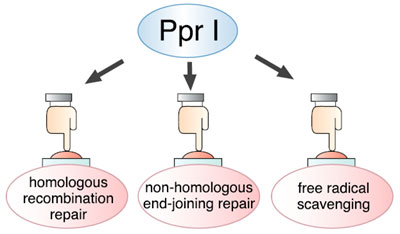The radioresistant bacterium Deinococcus radiodurans possesses an amazing capability to cope with radiation-induced DNA damage. DNA damage occurs not only through external triggers such as ionizing and ultraviolet radiation, but also by means of internal triggers such as DNA replication errors and free radicals generated in the process of respiration and other metabolic processes. It has been found that there exists an activation phenomenon in the expression of specific genes in D. radiodurans. However, how the gene expression is activated has been a continuing mystery.
Usually, it is possible to identify the gene responsible for the loss of the radiation resistance of a DNA repair-deficient mutant by transforming it with DNA from a normal strain, and by limiting the DNA region that can restore the DNA repair ability of the mutant. However, in the case of the DNA repair-deficient mutant strain KH8401, it is not possible to identify the responsible gene using the conventional method, because a small number of the cells have a predisposition to exhibit radioresistance at high frequency without being transformed by normal DNA (Fig. 6-8).
We have hypothesized that the unique property of strain KH8401 results from the transposition of a transposon that moves around in the genome, and compared the genomic distribution of transposons between the normal strain and the mutant. It was found that there exists a specific DNA region in which the insertion of a transposon was observed only in strain KH8401. By identifying the exact insertion site of the transposon, a novel gene responsible for the loss of radioresistance has been discovered. A protein made from this gene has been found to possess the property of activating the expression of genes involved in homologous recombination repair and non-homologous end-joining repair, as well as gene encoding for a free radical scavenger. This protein serves as a general switch for DNA repair and protection pathways. Therefore, we designate this protein as an inducer of pleiotropic proteins promoting DNA repair (PprI) (Fig. 6-9).
It is quite possible that surveillance of a group of genes under the control of PprI will help to uncover the full scope of the radioresistance of D. radiodurans. On another front, the PprI protein might also open the gate for developing a biological dosimeter that can be used over a wide range of doses.
|

